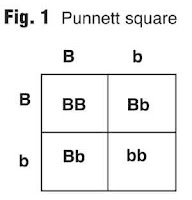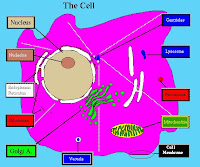
Friday, November 21, 2008
Punnett Square
A Punnett square is a chart that shows all possible combinations of alleles that can result from a genetic cross. The possible alleles from one parent are written across the top and the possible alleles from the other parent are written down the left side. The combined alleles in the boxes of the Punnett squre represent all the possible combinations in the offspring. Ina genetic cross, the allele that each parent will pass on to its offspring is based on probablility.

Tuesday, November 11, 2008
Heredity and Genetics
An organism's traits are controlled by the alleles it inherits from its parents. In a genetic cross, the allele that each parent will pass on to its offspring is inherited based on prbability. An organisms's phenotype is its physical appearance, or visible traits. An organism's genotype is its genetic makeup, or allele combinations.
Chromosomes are made up of many genes joined together like beads on a string. According to the chromosome theory of inheritance, genes are carried from parents to their offspring on chromosomes. During meiosis, the chromosome pairs separate and are distributed to two diffent cells. The resulting sex cells have only half as many chromosomes as the other cells in the organism.
The order of the nitrogen bases along a gene fomrs a genetic code that specifies what type of protein will be formed. During protein synthesis, the cell uses information from a gen on a chromosome to produce a specific protein. Mutations can cause a cell to produce an incorrect protein during protein synthesis. As a result, the organism's traits or phenotype, may be different from what it normally would have been.
Some human traits are controlled by single genes with two alleles, and others by single genes with multiple alleles. Still other traits are controlled by many genes that act together. The sex chromosomes carry genes that determine whether a person is male or female. They also carry genes that determine other traits.
Chromosomes are made up of many genes joined together like beads on a string. According to the chromosome theory of inheritance, genes are carried from parents to their offspring on chromosomes. During meiosis, the chromosome pairs separate and are distributed to two diffent cells. The resulting sex cells have only half as many chromosomes as the other cells in the organism.
The order of the nitrogen bases along a gene fomrs a genetic code that specifies what type of protein will be formed. During protein synthesis, the cell uses information from a gen on a chromosome to produce a specific protein. Mutations can cause a cell to produce an incorrect protein during protein synthesis. As a result, the organism's traits or phenotype, may be different from what it normally would have been.
Some human traits are controlled by single genes with two alleles, and others by single genes with multiple alleles. Still other traits are controlled by many genes that act together. The sex chromosomes carry genes that determine whether a person is male or female. They also carry genes that determine other traits.
Saturday, October 11, 2008
Cells
Cells are the basic unit of structure and function in living things.
The cell theory states: All living things are composed of cells; cells are the basic unit of structure and function in livings things, all cells are produced from other cells.
Many of the compounds found in living things contain the element carbon. Most compounds that contain carbon are called organic compounds. Carbohydrates, proteins, lipids, and nucleic acids are important groups of organic compounds in living things. Compounds that do not contain the element carbon are called inorganic compounds.
Diffusion is the main method by which small molecules move across the cell membrane. Many cellular processes depend on osmosis. The main difference between passive transport and active transport is that active transport requires the cell to use its own energy while passive transport does not.
All living things obtain energy either directly or indirectly from the energy of sunlight. Photosynthesis is a process in which plants and some other organisms use energy from the sun to convert carbon dioxide and water into oxygen and glucose. During respiration, cells break down simple food molecules such as sugar and release the energy they contain. Fermentation provides energy for cells without using oxygen.
During interphase, the cell grows, makes a copy of its DNA, and prepares to divide into two cells. During mitosis, one copy of the DNA is distributed into each of the two daughter cells. During cytokinesis, the cytoplasm divides, distributing the organelles into each of the two new cells.
The cell theory states: All living things are composed of cells; cells are the basic unit of structure and function in livings things, all cells are produced from other cells.
Many of the compounds found in living things contain the element carbon. Most compounds that contain carbon are called organic compounds. Carbohydrates, proteins, lipids, and nucleic acids are important groups of organic compounds in living things. Compounds that do not contain the element carbon are called inorganic compounds.
Diffusion is the main method by which small molecules move across the cell membrane. Many cellular processes depend on osmosis. The main difference between passive transport and active transport is that active transport requires the cell to use its own energy while passive transport does not.
All living things obtain energy either directly or indirectly from the energy of sunlight. Photosynthesis is a process in which plants and some other organisms use energy from the sun to convert carbon dioxide and water into oxygen and glucose. During respiration, cells break down simple food molecules such as sugar and release the energy they contain. Fermentation provides energy for cells without using oxygen.
During interphase, the cell grows, makes a copy of its DNA, and prepares to divide into two cells. During mitosis, one copy of the DNA is distributed into each of the two daughter cells. During cytokinesis, the cytoplasm divides, distributing the organelles into each of the two new cells.

Sunday, September 21, 2008
Characteristics of Living Things
Living things all share a few common characteristics. Living things are made of cells, contain similar chemicals, use energy, respond to their surroundings, grow and develop, and reproduce. All organisms need water food, living space , and stable internal conditions. Homostasis is the process by which an organism's internal environment is kept stable ins pite of changes in external environment.
Thursday, September 11, 2008
A (The) Scientific Method
Every science class that you will ever take will begin by refreshing or reteaching "THE" scientific method. But, I like to think of it as "A" scientific method.
Everyone of us uses our five senses to investigate the world around us. We are all naturally investigative scientist. These are a few of the skills to be a true scientist. Other skills such as inferring and predicting are equally important. Scientific attitudes play an important part in all investigations as well, to include, curiosity, honesty, open-mindedness, skeptiscism and creativity.
The steps of "A" scientific method-
1. Make an observation,
2. Ask a question,
3. Form a hypothesis,
4. Conduct an experiment,
5. Collect data - accept or reject hypothesis.
Everyone of us uses our five senses to investigate the world around us. We are all naturally investigative scientist. These are a few of the skills to be a true scientist. Other skills such as inferring and predicting are equally important. Scientific attitudes play an important part in all investigations as well, to include, curiosity, honesty, open-mindedness, skeptiscism and creativity.
The steps of "A" scientific method-
1. Make an observation,
2. Ask a question,
3. Form a hypothesis,
4. Conduct an experiment,
5. Collect data - accept or reject hypothesis.
Monday, August 11, 2008
Doing Science Safely
Good preparation helps you stay safe when doing scientific investigations.
An accident happens because of the lack of forthought.
Always read procedures before beginning any investigaton.
Follow all written and oral directions.
When an accident occurs, not matter how minor, notify your teacher immediately
An accident happens because of the lack of forthought.
Always read procedures before beginning any investigaton.
Follow all written and oral directions.
When an accident occurs, not matter how minor, notify your teacher immediately
Subscribe to:
Posts (Atom)